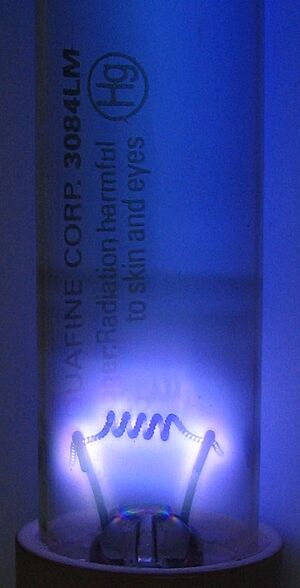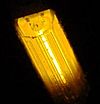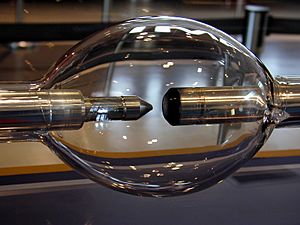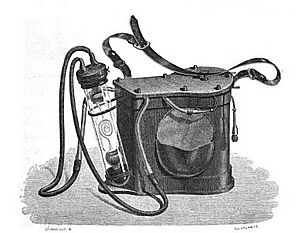Gas-discharge lamp facts for kids

Imagine a special kind of light bulb that makes light by sending electricity through a gas! These are called gas-discharge lamps. They work by making the gas inside glow, turning it into something called plasma, which is like a super-hot, electrically charged gas.
These lamps usually have special gases inside, like argon, neon, krypton, or xenon. Sometimes, they also contain other things like mercury or sodium. These extra materials turn into vapor (gas) when the lamp starts up.
Some lamps, like the sodium-vapor lamp used in streetlights, are self-starting. They have a special glass tube and a metal cap.
So, how do they make light? When electricity flows through the gas, it makes tiny particles called electrons leave the gas atoms. This leaves the atoms with a positive charge, and they become ions. The free electrons zoom towards one end of the lamp (the anode). The positive ions rush towards the other end (the cathode).
As these ions move, they crash into other neutral gas atoms. When they hit, they can knock electrons off those atoms, creating more ions. The atoms that lost an electron then speed towards the cathode. But here's the cool part: the ions that gained an electron go back to a lower energy state. When they do this, they release energy as tiny packets of light called photons. This is how the lamp glows!
The color of the light depends on the type of gas inside. Different gases glow with different colors. You can get a wide range of colors from gas-discharge lamps. Some lamps even make ultraviolet light, which we can't see. But they have a special coating inside that turns this invisible light into visible light. The fluorescent lamp is a great example of this.
Compared to old-fashioned incandescent lamps (the ones with a glowing wire), gas-discharge lamps are much more energy-efficient. This means they use less electricity to make the same amount of light. However, they are more complex to build. They also need special equipment called a ballast to control the electricity flow. This stops the current from getting too high and damaging the lamp.
Some gas-discharge lamps also take a little time to warm up and reach their full brightness. Even with these extra parts, they were very popular for many years because they saved so much energy. That is, until newer LED lamps came along!
Contents
History of Gas-Discharge Lamps
The story of gas-discharge lamps began way back in 1675. A French astronomer named Jean Picard noticed something strange. The empty space in his mercury barometer glowed when he moved it! People like Francis Hauksbee then tried to figure out why.
Hauksbee showed off the first gas-discharge lamp in 1705. He used a glass globe with some mercury inside. When he charged it with static electricity, it made enough light to read by! Later, in 1809, Sir Humphry Davy showed off the electric arc. This is a bright, continuous spark of electricity. Scientists realized that these electric discharges could make light much more efficiently than burning wires.
The real breakthrough for low-pressure gas tubes came from a German glassblower named Heinrich Geissler. Starting in 1857, he made colorful, artistic tubes filled with different gases. These were called Geissler tubes. They glowed with many different colors! Scientists found that gases like neon, argon, krypton, and xenon worked very well.
This amazing technology was turned into a business by a French engineer, Georges Claude, in 1910. This led to the famous neon lighting we see in bright neon signs today.
Later, lamps were developed that included metal vapors. The heat from the electricity would turn metals like sodium and mercury into gas. This gas then produced light. These lamps are known for their strong, visible light.
Over a hundred years of research have led to even more advanced lamps. Some don't even have electrodes! They use microwaves or radio waves to make the gas glow. Smaller versions of these lamps are now used in homes too.
The "Ruhmkorff" Lamp
The Ruhmkorff lamp was an early portable electric light, first used in the 1860s. It was named after Heinrich Daniel Ruhmkorff. This lamp used a Geissler tube powered by a battery and a special coil. This coil could turn low-voltage battery power into quick, high-voltage zaps.
At first, these lamps used carbon dioxide gas to make white light. But the carbon dioxide didn't last long. So, later lamps used nitrogen gas, which made a red light. The clear glass was also replaced with uranium glass, which glowed green.
These lamps were designed for dangerous places like mines, where there could be explosive gases. They were also useful for divers or as a cool light for surgery. Two people, Alphonse Dumas (an engineer) and Dr. Camille Benoît (a doctor), developed the lamp in France. In 1864, they even won an award for their invention! The Ruhmkorff lamp became famous after being mentioned in several of Jules Verne's science-fiction novels.
Colors of Gas-Discharge Lamps
Each type of gas has its own special way of glowing. This is called its emission spectrum. It's like each gas has its own unique light fingerprint, which determines the color of the light it produces.
Scientists use something called the color rendering index (CRI) to see how well a light source shows true colors. Some gas-discharge lamps have a low CRI. This means that colors might look different under their light compared to how they look under sunlight.
| Gas | Color | Spectrum | Notes | Image |
|---|---|---|---|---|
| Helium | White to orange; can also be gray, blue, or green-blue. | Artists use this for special lighting effects. |  |
|
| Neon | Red-orange | Very bright light. Used a lot in neon signs. |  |
|
| Argon | Violet to pale lavender blue | Often mixed with mercury vapor. |  |
|
| Krypton | Gray off-white to green. Can be bright blue-white at high power. | Used by artists for special lighting. |  |
|
| Xenon | Gray or blue-gray dim white. Can be very bright green-blue at high power. | Used in flashlamps and car headlights. |  |
|
| Nitrogen | Similar to argon but duller, more pink; can be bright blue-white at high power. | Used in older "Moore lamps." | ||
| Oxygen | Violet to lavender, dimmer than argon. | |||
| Hydrogen | Lavender at low power, pink to magenta at higher power. | |||
| Carbon dioxide | Blue-white to pink, brighter than xenon at lower power. | Used in carbon dioxide lasers and older "Moore lamps." |  |
|
| Mercury vapor | Light blue, strong ultraviolet light. | Used with special coatings to make many colors. Common in mercury-vapor lamps and fluorescent tubes. | ||
| Sodium vapor (low pressure) | Bright orange-yellow | Very common in sodium-vapor lamps for streetlights. |  |
Types of Gas-Discharge Lamps
Gas-discharge lamps are grouped by the gas pressure inside and whether their electrodes (the parts that carry electricity) get hot.
- Hot cathode lamps have electrodes that get very hot. This heat helps release electrons, which keeps the light going. Many types have thin wire filaments that heat up first to start the light.
- Cold cathode lamps have electrodes that stay at room temperature. They need a very high voltage to start the gas glowing.
Low-Pressure Discharge Lamps
These lamps have gas pressure much lower than the air around us. For example, a common fluorescent lamp has gas pressure that's less than 1% of normal air pressure.
- Fluorescent lamps are hot-cathode lamps. They are the most common type of light in offices and many homes. They are very efficient, producing a lot of light for the electricity they use.
- Neon lighting uses long, thin tubes filled with different gases at low pressure. A high voltage makes them glow. They are famous for bright advertising neon signs.
- Low-pressure sodium lamps are the most efficient gas-discharge lamps. They produce a very bright orange-yellow light. However, they make colors look very dull. So, they are mostly used for street lighting where color isn't as important.
- A small discharge lamp with a special switch is used to start a fluorescent lamp. The heat from the tiny discharge makes the switch work.
- Flicker light bulbs are special lamps that make a flickering effect. They usually contain neon and helium gas. The gas moves randomly between two flame-shaped electrodes, making the light look like a candle flame.
High-Pressure Discharge Lamps
These lamps have gas pressure that is similar to, or even higher than, the air around us. For example, some car headlights have gas pressure that's 50 times normal air pressure!
- Metal halide lamps produce a light that is almost white. They are very efficient. You might see them lighting up tall buildings, parking lots, shops, or sports fields.
- High-pressure sodium lamps produce a broader range of light colors than low-pressure sodium lamps. They are also used for street lighting and to help plants grow.
- High-pressure mercury-vapor lamps are an older type of high-pressure lamp. They have mostly been replaced by metal halide and high-pressure sodium lamps today.
High-Intensity Discharge (HID) Lamps

HID lamps are a type of electric light that makes light from a strong electric arc. This arc happens between two tungsten electrodes inside a special tube made of quartz or alumina. Compared to other lamps, HID lamps pack a lot of power into a small arc.
Examples of HID lamps include mercury-vapor lamps, metal halide lamps, and xenon arc lamps. HID lamps are usually chosen when you need a lot of light and want to save energy.
Other Examples of Gas-Discharge Lamps
The Xenon flash lamp makes a single, very quick flash of light. These are commonly used in cameras for photography and in theater lighting. Stronger versions, called strobe lights, can make many flashes in a row. This is used to study fast movements, in medicine, and for cool effects in dance halls.
Alternatives to Gas-Discharge Lamps
- Incandescent lamps: These are the old-fashioned light bulbs with a glowing wire. They are cheap to make but use a lot of electricity.
- White LED lamps: These are modern lights that use light-emitting diodes. They are very energy-efficient and are becoming more and more popular.
- Battery-powered lanterns: Some lanterns use krypton or xenon gas to produce light.
See also
 In Spanish: Lámpara de descarga para niños
In Spanish: Lámpara de descarga para niños
- Electric arc
- Electric glow discharge
- Emission spectrum
- Fluorescent lamp
- Gas-filled tube
- Hydrargyrum medium-arc iodide lamp
- List of light sources
- Over-illumination


